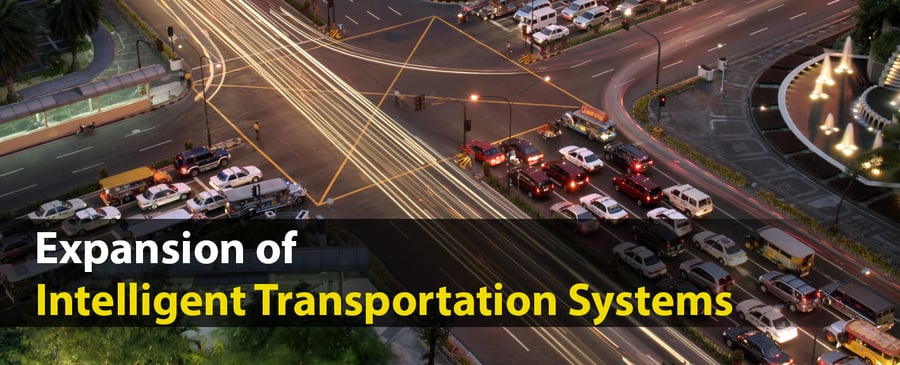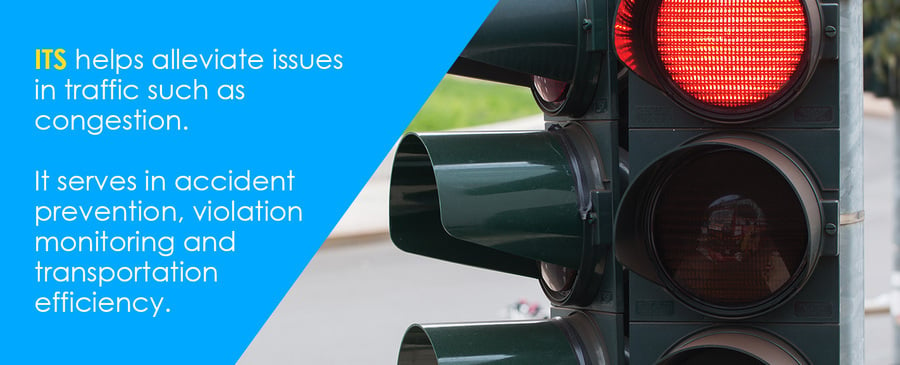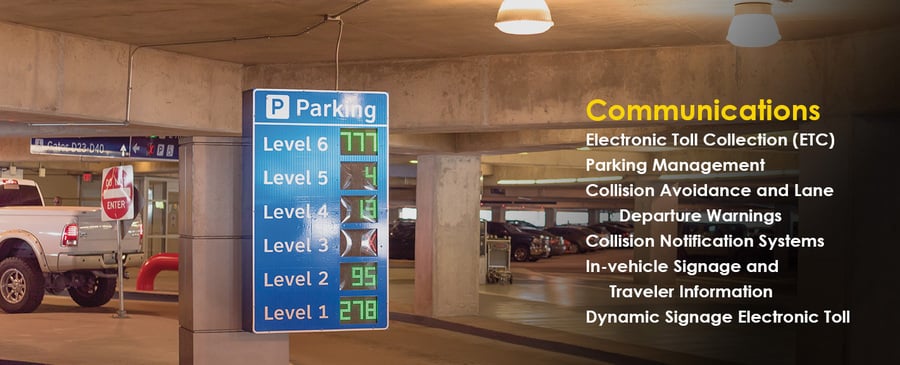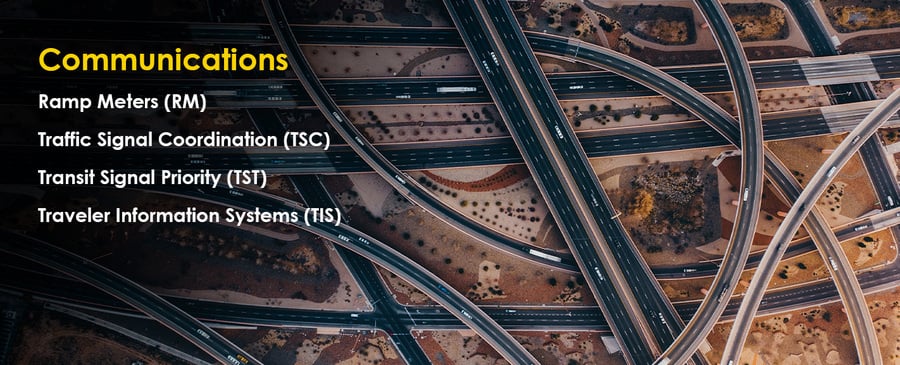{{ quickViewProduct.product_title }}
Stock ID
{{ quickViewProduct.product_stock_number }}
Product Features:
- {{ feature.product_feature_description }}
{{ option.product_option_title }}
{{ value.product_option_value_title }}

The most important, primary goal of Intelligent Transportation Systems (ITS) is to improve safety, mobility, and productivity. Intelligent Transportation Systems are found on roadways, interstates and intersections. Many devices rely heavily upon network infrastructure. They can support advanced functions.
ITS refers to the use of communications and information technology (IT) resources that offer solutions to traffic issues. With this in mind, some of these issues include; congestion, accident prevention, violation monitoring and transportation efficiency. The United States Department of Transportation defines ITS as technologies that advance transportation safety and mobility. They also enhance American productivity by integrating advanced communications technologies into transportation infrastructure and vehicles. This application is vehicle 2x or vehicle to anything.
Intelligent Transportation Systems encompass a broad range of wireless traditional communications-based information as well as electronic technologies.
At the surface level, ITS alleviates issues in traffic such as congestion. It serves in accident prevention, violation monitoring and transportation efficiency.

ITS is a critical component of the growing world of smart cities. In addition, it is adapting to the changing needs for maintaining and improving transportation systems. Half the world's population lives in cities, by estimation. As a result, many cities involve complex infrastructure and high population density. They have outdated traditional transportation planning and environmental issues that do not support smart city technology. Communication network systems are inadequate. Sound infrastructure is required in the development of frameworks for smart cities. Frameworks also require the capability to adopt new infrastructure methods and technologies.
Urban areas are facing initiatives to improve the quality of life as well as the efficiency and productivity of their communities. With that in mind, ITS is playing an important role in how we transport people, goods, energy, and information. Network convergence is the name of this trend.
Intelligent Transportation Systems include both hardware and software, while also utilizing both manual and automatic processes. And ITS has the capability to simultaneously collect, process, share and analyze data on the effective flow of transportation. As ITS continues to develop, we will find ourselves integrating more autonomous technologies, removing the human element of error. Processes will become smoother, more efficient, and increase productivity and safety.
Often ITS runs on hybrid fiber coax (HFC) or fiber-optic networks. This integrates existing hardware and coaxial cabling with new technologies and devices. HFC networks are designed to work with older coax cable or twisted pair and bring fiber to old infrastructure. This keeps construction costs down. It is more beneficial to leave the existing infrastructure in place. Then fiber can be delivered to a certain point in the network.
If two types of cables are used, network switches or media converters enable technicians to connect fiber to the existing cables. Additions like this can help to improve connectivity and speed or allow for longer communication ranges.
Common data collection devices are devices that are interconnected via cabling (coax, HFC or fiber). Furthermore, these integrate into the internet to create an efficient network for transportation. Some of the common data collection devices used are:
Inductive Loop Detectors are coiled wires installed beneath or at the surface of a roadway. These are used to collect information on speed.
Video Imaging Processors are overhead traffic cameras collecting images and video to classify vehicles and provide information on lane occupancy or speed. The use of cameras does have some drawbacks such as; weather, glare or possible lens shatter. These all play a role in impeding the footage.
Speed Sensors improve safety and law enforcement or compliance by detecting movement. Examples include lasers, radars, and ultrasonic sensors.
With data analysis and processing tools, we can manage collected data. These tools eliminate the human element. They reduce error and increase speed and efficiency in critical transportation scenarios.
Examples of ITS devices that process data:
Data Fusion analyzes multiple data inputs from several different sensors. (inductive loop devices, video imaging processors, speed sensors).
Automatic Incident Detection is a system that can notify traffic control centers with technology or alerts on events. Examples of this are collisions, stopped vehicles and animals in the street.
GPS can pull live data from vehicles such as public transit busses, emergency vehicles and maintenance crews. This allows for information to set stop light length. This can control more or less traffic depending on the information pulled.

Because traffic involves the public and its understanding of road conditions, communication with drivers and vehicles is critical. Sending data to external entities is another task that often falls to ITS, with its fast transmission speeds and reliability. Some technology that helps with data communication includes the following:
Electronic Toll Collection (ETC) – used to increase the convenience and efficiency of toll collection
Parking Management – alleviates congestion of busy areas through open parking spot notification lights or apps.
Collision Avoidance and Lane Departure Warnings – some newer vehicles are equipped with technology that can wirelessly transmit V2V information.
Collision Notification Systems – This sends an alert when changing lanes or when another vehicle or object is too close.
In-vehicle Signage and Traveler Information – This displays road signs to smartphones or car GPS. It also provides updates on weather, accidents, and speed limits.
Dynamic Signage – Easily updatable interstate signage to notify drivers of excessive traffic, traffic delays or lane closures.
Collected data may be utilized to perform a wide variety of other functions.
Ramp Meters (RM) – Controls the flow of vehicles entering the freeway.
Traffic Signal Coordination (TSC) – GPS and public transportation can be synchronized at intersections to enhance directional movement.
Transit Signal Priority (TST) – Gives special treatment to transit vehicles to signal street lights at intersections.
Traveler Information Systems (TIS) – Includes internet, websites, apps, television, phone hotlines, in addition to radio. Each provide more informed decisions regarding trips and routes in transportation.

We are working to expand our infrastructure to accommodate the leap forward into ITS and vehicle to anything technologies. Historically, Intelligent Transportation Systems run on hybrid networks, integrating existing hardware and cabling with these new technologies. Fiber optic cabling can handle the higher bandwidth as well as power requirements of more advanced technologies.
HFC networks were the primary network when ITS was first developed. However, now we have full end-to-end fiber networks that handle the more advanced technologies.
FTTX is the latest trend in the telecommunications industry. FTTX stands for fiber to the X. X represents the location where the fiber is being routed. The technology responsible for transmitting or receiving information over the network will vary due to what the X is. Intelligent Transportation Systems can be thought of as any other X application.
Fiber optic cable has been replacing twisted copper as well as coaxial pairs for various transmission formats. Fiber optics also provide high bandwidth and signal immunity which are better for traveling long distances. The most pressing applications are those where the data collection occurs at a distance from its storage or processing location. For example, a traffic control system. Fiber optics can also help municipalities prepare for future, next-generation technology with the necessary equipment.
The benefits of smart traffic management systems extend beyond drivers. Pedestrians, cyclists, public transit riders, governments, law enforcement agencies and the environment can also see the advantageous effects.
Reducing Congestion – Minimizes environmental emissions and fossil fuels from cars sitting in traffic. This reduces gasoline usage, and drive times thus creating a more appealing environment.
Increasing the Appeal of Public Transit – Transportation can save you time and money. With this in mind, citizens are more likely to use it.
Enhanced Flexibility – Wide array of technologies makes it possible for cities to cater to its citizens in new ways. Signal Coordination Systems improve overall traffic patterns.
Supporting Tourism and Economy – Reducing congestion provides a more enjoyable experience
Improving Safety and Response Times – Signal Coordination Systems provide necessary timing to prevent traffic backup or limited pedestrian crossing times.
Improving Compliance – Enforcement agencies may use Cameras or parking spot occupancy detector technologies to prevent issues.
Collecting Better Data – Provide information about the area and its citizens to better match their needs.
These benefits are the result of having a reliable network infrastructure. The infrastructure relies on the devices used to; collect, process, analyze, and implement information for the improvement of safety, mobility, and productivity.
Back to MultilogRemote power management system
Smart Tracker - a hardened, programmable outlet strip that enables power and control of up to 8 devices remotely.Uninterruptible power supply
EP Line-Interactive Series - provides a steady, regulated AC output power to operate traffic signals, camera equipment, and additional applications used in Departments of Transportation and Intelligent Traffic Systems (ITS/Traffic).
EDP Double-Conversion Series - an uninterruptible power supply designed to provide high quality, stable AC power to critical equipment that requires continuous, regulated power.Power transfer switches
Safety Automatic Transfer Switch - has an operating temperature of -37°C to +74°C and provides automatic power source selection, generator capabilities, and alarm reporting via dry contact relays.
Standard Transfer Switch - includes a maintenance bypass switch with an operating temperature of -37°C to +74°C.Splice enclosures
Starfighter Dome Series and Starfighter In-Line Series- The Starfighter enclosures can be installed above or below grade and require no special tools for installation.
Optima™ Series - uses standard connectors thus eliminating the need to stock different lengths of pre-terminated drops, allowing field termination and preventing drop fiber waste.
Fiber Tap Plus™ Series - designed for fiber builds where a hardened connector is the preferred method of drop deployment.Fiber termination panels
Signature Series Rack Mounts - engineered from the ground up with many features and options available. Each rack mount can be customized with up to 288 fiber connections using traditional (and readily available) adapter panels and 144 connections using our patented CT-X cassettes.
Slim Tap - developed for use where a minimal amount of connections are needed and space is limited.Fiber optic cables
Pre-terminated Fiber Assemblies - Options include jumpers, pigtails, and drop cables with standard connectors and adapters (SC, LC, ST, IP) as well as a host of other choices.
For more information on how Multilink can help you establish maintenance routines, train your technicians, or aid in the planning of your rural broadband network contact our team at 440-366-6966.